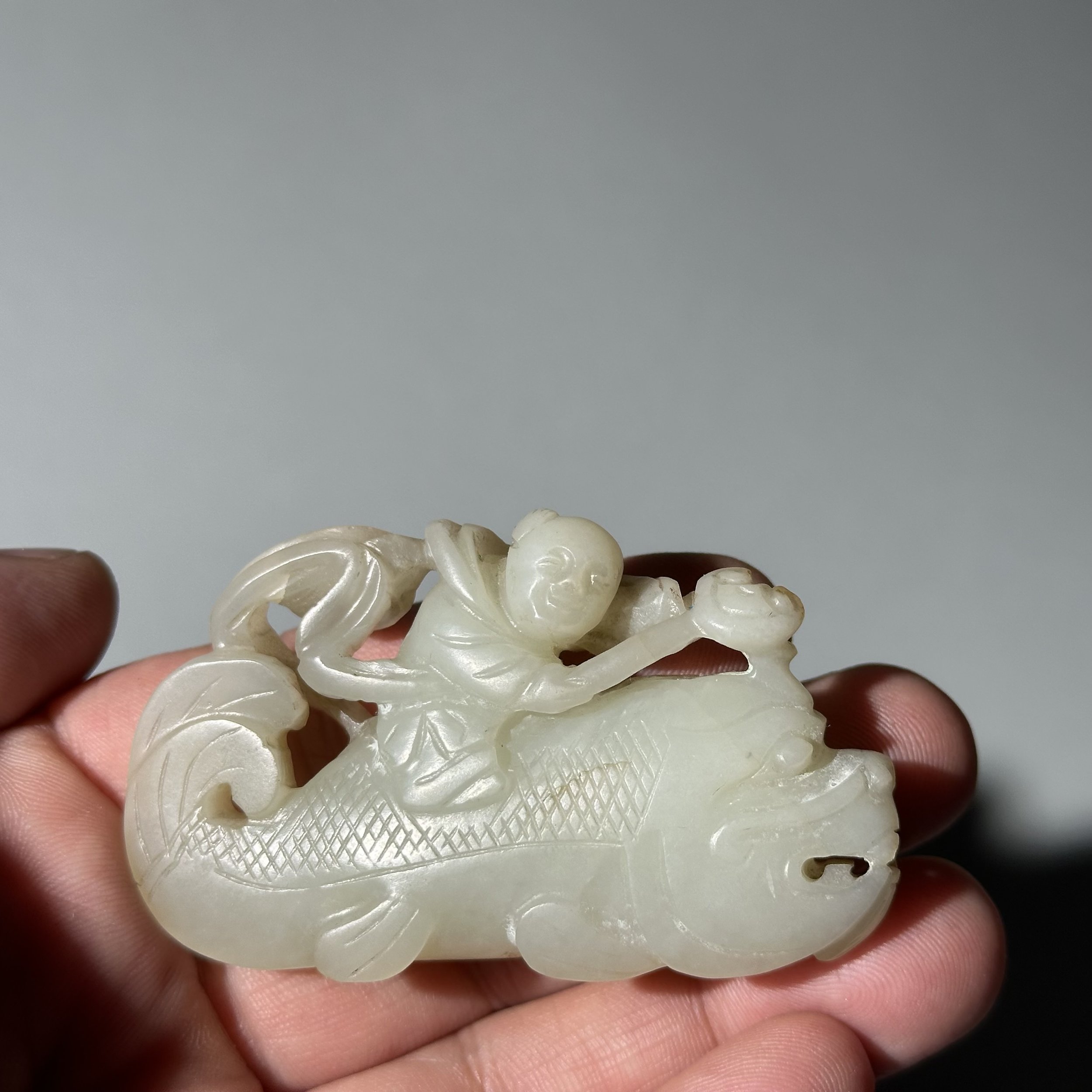 Image 1 of 10
Image 1 of 10

 Image 2 of 10
Image 2 of 10

 Image 3 of 10
Image 3 of 10

 Image 4 of 10
Image 4 of 10

 Image 5 of 10
Image 5 of 10

 Image 6 of 10
Image 6 of 10

 Image 7 of 10
Image 7 of 10

 Image 8 of 10
Image 8 of 10

 Image 9 of 10
Image 9 of 10

 Image 10 of 10
Image 10 of 10











White jade figure of a boy riding a fish dragon
China
Qing Dynasty (1644-1912), Qianlong Period (1736-1795)
Carved from white/very pale celadon coloured jade of even hue as a boy with flowing scarves holding a ruyi sceptre, riding a dragon fish. Together with a fitted zitan stand appropriately carved as waves, dating from the late Qing to Republic Period. The jade 4cm high, 6.5cm wide. With stand 5.5cm high.
Provenance: Collection of Colonel Kenneth Earnest Frederick Millar (1905-1995), and thence by descent. Colonel Millar served with the British Army in its Border Regiment for twenty-six years, travelling in China on official business numerous times between 1927 and 1949, documenting political, social, economic, geographic and political conditions in China. He rose to the rank of Major, before taking a position in Canberra in Australia with the Department of Defence as a Senior Research and Defence officer in 1952. He formed his collection of Chinese works of art during his time travelling in China between 1927 and 1949, a golden period for collecting Chinese art.
Cat. 676
Symbolism
The dragon-headed fish in the context of this jade likely symbolises ‘yu yue longmen’ - the carp leaping up through the dragon’s gate, or alternatively could represent ‘Ao’, the mythical sea turtle, a sculpture of which was stood upon in Beijing by the ‘zhuangyuan’ (the scholar who achieved the top rank) - either way representing success in the Imperial examinations. The word ‘ruyi’ (which the boy holds in his hand) translates to ‘as you wish’. Thus it represents a wish to a boy for achieving success in scholarly endeavours or more specifically the Imperial examinations.
China
Qing Dynasty (1644-1912), Qianlong Period (1736-1795)
Carved from white/very pale celadon coloured jade of even hue as a boy with flowing scarves holding a ruyi sceptre, riding a dragon fish. Together with a fitted zitan stand appropriately carved as waves, dating from the late Qing to Republic Period. The jade 4cm high, 6.5cm wide. With stand 5.5cm high.
Provenance: Collection of Colonel Kenneth Earnest Frederick Millar (1905-1995), and thence by descent. Colonel Millar served with the British Army in its Border Regiment for twenty-six years, travelling in China on official business numerous times between 1927 and 1949, documenting political, social, economic, geographic and political conditions in China. He rose to the rank of Major, before taking a position in Canberra in Australia with the Department of Defence as a Senior Research and Defence officer in 1952. He formed his collection of Chinese works of art during his time travelling in China between 1927 and 1949, a golden period for collecting Chinese art.
Cat. 676
Symbolism
The dragon-headed fish in the context of this jade likely symbolises ‘yu yue longmen’ - the carp leaping up through the dragon’s gate, or alternatively could represent ‘Ao’, the mythical sea turtle, a sculpture of which was stood upon in Beijing by the ‘zhuangyuan’ (the scholar who achieved the top rank) - either way representing success in the Imperial examinations. The word ‘ruyi’ (which the boy holds in his hand) translates to ‘as you wish’. Thus it represents a wish to a boy for achieving success in scholarly endeavours or more specifically the Imperial examinations.
